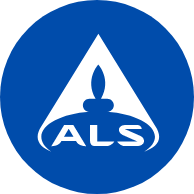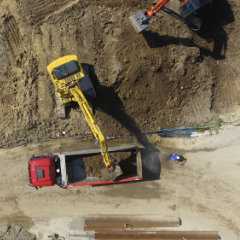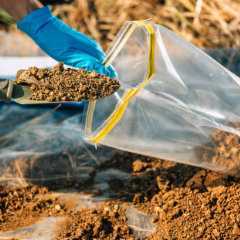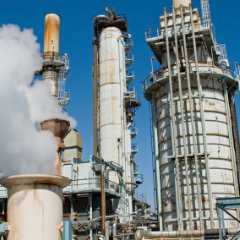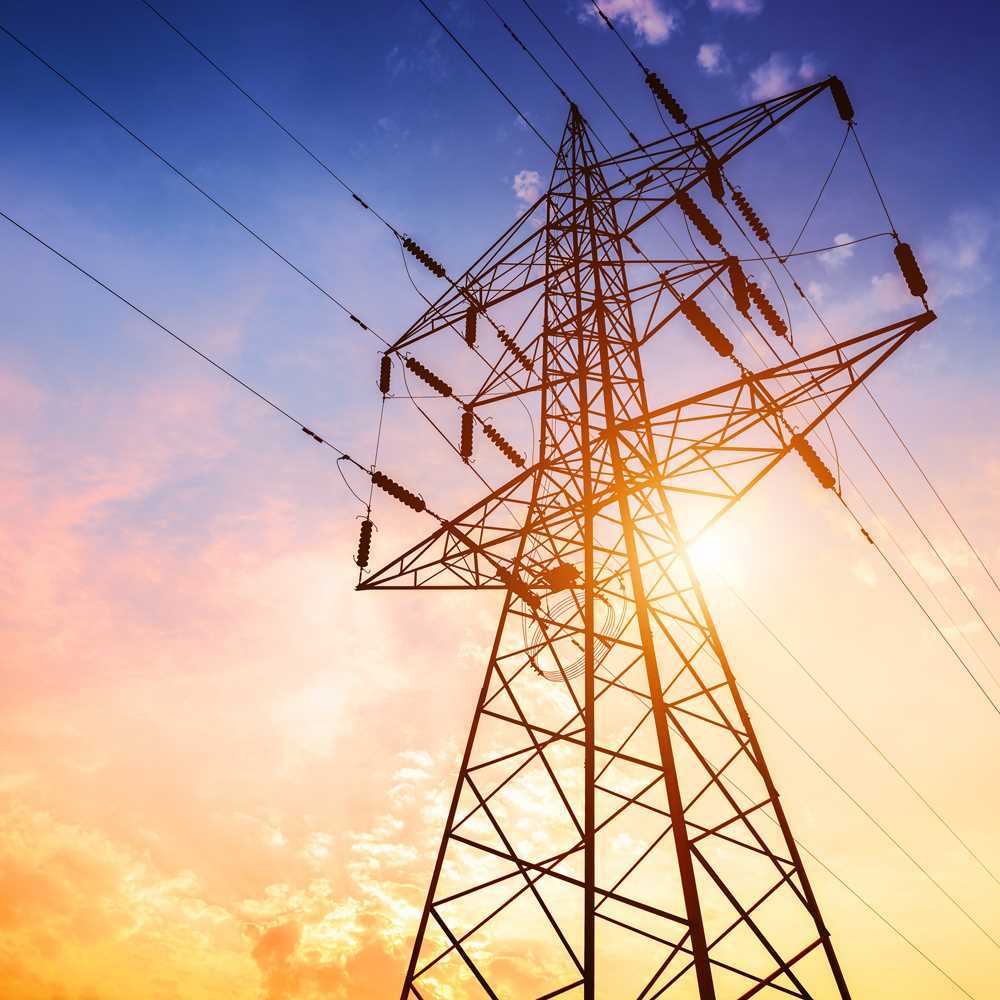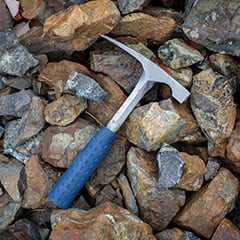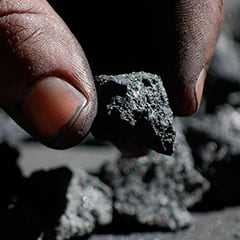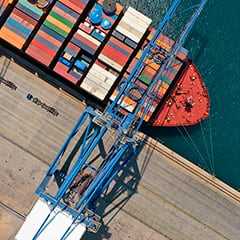EnviroMail 70 Canada
Dustfall Monitoring for the Canadian Mining and Industrial Sectors
Dustfall analysis refers to the measurement of particulate matter that settles from air onto surfaces over time, and has been used for decades to gauge nuisance dust levels (“soiling”) around mines, quarries, industrial sites, and communities, often as part of broader air quality or environmental effects monitoring programs. Unlike real-time air quality measurements like PM2.5 or PM10, dustfall monitoring provides an aggregate time-weighted measure of settleable dust deposition, usually expressed in mass per unit area per day.
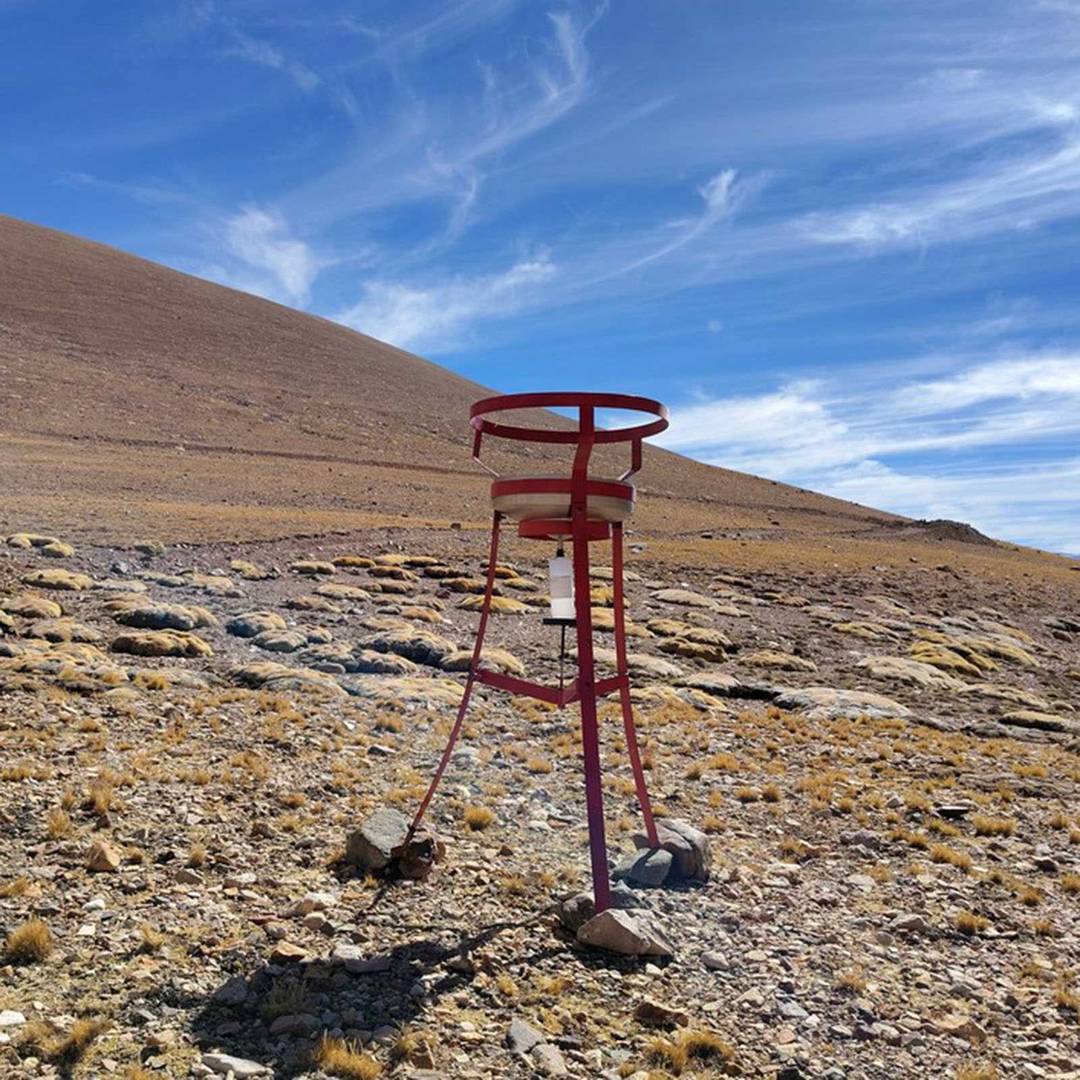
Dustfall canisters placed near mine sites or around industrial site perimeters help track the extent and quantity of dust deposition. Test results help to evaluate the effectiveness of dust mitigation measures (road watering, dust suppressants, etc.), and may support assessments of potential impacts on soils and surface water. Dustfall monitoring is a cost-effective technique for assessing broad trends in dust deposition and can serve as a screening tool to indicate when operational adjustments are needed to manage dust levels for aesthetic or regulatory purposes, or where more advanced monitoring techniques are required.
Dustfall Analysis Methods
The standard method for dustfall analysis uses a passive collection technique, typically following ASTM D1739, Standard Test Method for Collection and Measurement of Dustfall,1 which involves exposing an open container to the air for a fixed period (usually 30 days) to collect settling particles. The sample container is partially filled with deionized water (with additives) so that settling dust is captured in the liquid. After the exposure period, the entire contents (liquid plus settled dust, including any rain or snow) is sealed and sent to a laboratory for analysis. The lab sieves out extraneous materials larger than ~ 1 mm and evaporates the sample to accurately weigh the collected particulate. Results are reported as dustfall deposition rate, typically in milligrams per square decimeter per day (mg/dm²-day).
Laboratories normally report Total Dustfall (dried at 105°C). Upon request, this measurement can be further divided into Fixed Dustfall and Volatile Dustfall components, determined by ignition at 550°C. Volatile fractions consist primarily of organic material such as pollen, plant debris, or insects, while fixed fractions represent mineral content. For further characterization, any of these test categories can be further divided into water-soluble and insoluble particulate matter fractions by filtration through a 0.45 µm membrane filter, which can distinguish salt-derived dustfall from soil dust. In mining applications, dustfall samples are often analyzed for metal content to assess environmental deposition of trace metals.
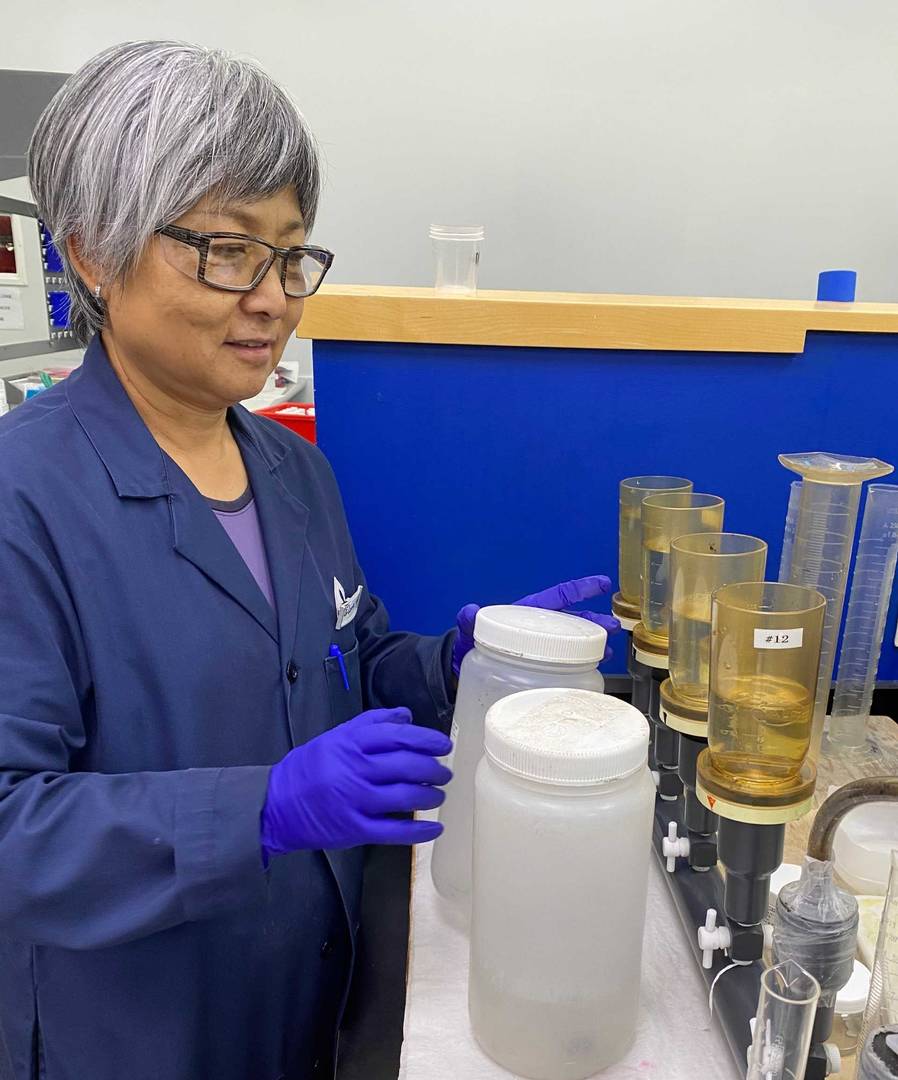
Fig 1. Dustfall analysis
Dustfall Sampling Apparatus
Dustfall is collected in a wide-mouth container with tight-fitting lid, typically made from HDPE, which supports trace metals testing if needed. Common sizes are 2-4 L, with opening diameter of ~10-15 cm, where container depth is at least twice its diameter. Sample containers are typically supplied by an accredited laboratory, pre-charged with deionized water (~500–1,000 mL), usually with additives appropriate to sampling conditions. A mild algaecide prevents algal growth in mild weather, and an antifreeze agent (typically isopropyl alcohol) prevents freezing in cold weather, which would stop dust entrapment. To prevent artifacts from prior sampling events, disposable single-use canisters are recommended where both gravimetric and metals analyses are required.
Site collection apparatus should be situated approximately 2 m above ground to avoid ground-level disturbances, with a wind shield to improve sampling precision, as described by ASTM D1739. Some installations may require animal deterrents (e.g., to prevent contamination by bird droppings, or interference by larger animals).
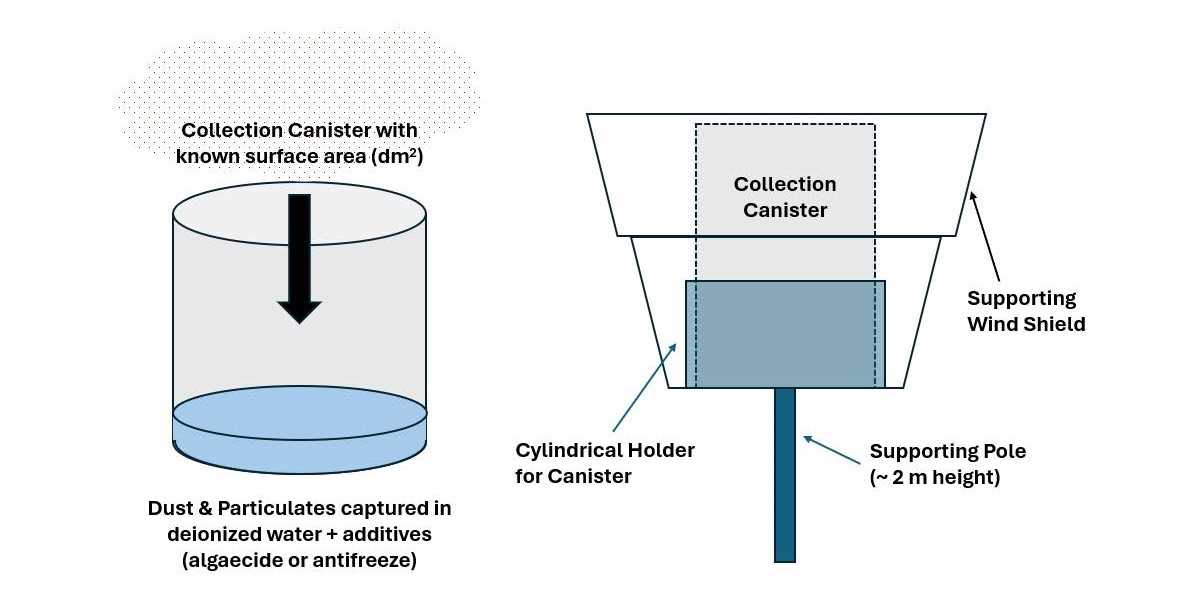
Fig 2. Components of a Dustfall Sampler
Field Deployment
Dustfall monitoring locations should be in open areas with unobstructed airflow for at least 20 m in all directions. Multiple stations are often established around a site boundary and at sensitive receptors (e.g., communities, water bodies, ecological sites). For mines, samplers are commonly placed along a transect downwind of operations and at upwind reference locations. Field duplicate samples are often used as quality control to assess sampling precision. The container is opened at the start of the sampling period, and installation details are recorded.
Since the exposure period is long (typically 30 days), field technicians should check samplers periodically. If the liquid level gets within ~2.5 cm of the top due to rain or snow, a fresh container should be deployed, with both the original and new containers submitted to the lab for combination. In hot conditions, evaporation can be an issue; larger initial volumes can be requested from the lab, or if the liquid level is nearing dryness (< 5 cm), technicians can add deionized water supplied by the laboratory. All material retained in the canister < 1 mm in size will be included with lab analysis, which may include non-dust interferences such as pollen, bird droppings, insect remnants, plant detritus, etc. Samples that have become dry or have overflowed due to precipitation are invalid.
After the sampling period, the canister is taken down and closed with lid secured. Samples are shipped to the laboratory with a chain-of-custody (CoC) form listing sample IDs, dates, and requested analyses (e.g., dustfall particulate species, metals). Detection limits for gravimetric dustfall fractions are ~0.1 mg/dm²-day.
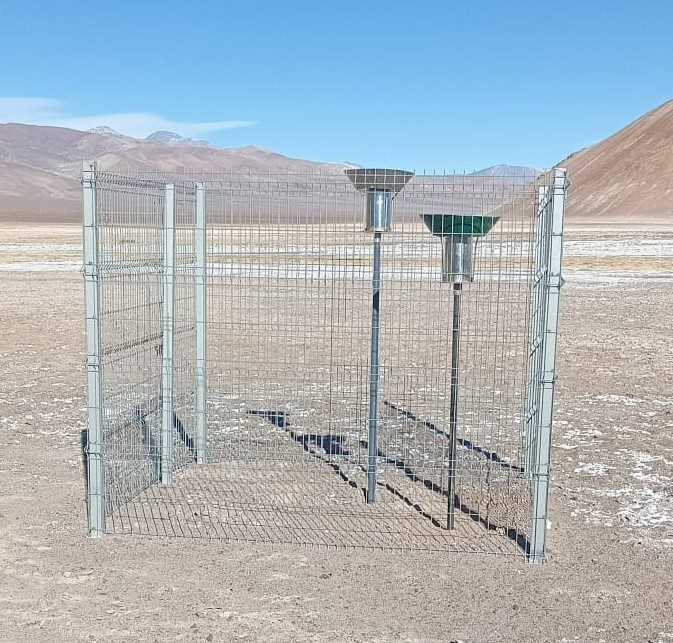
Fig 3. Duplicate Dustfall Samplers near a mine
Regulatory Requirements and Guidelines in Canada
Dustfall is generally considered a nuisance or aesthetic indicator rather than a direct health metric, which is reflected in Canadian regulations and guidelines. There are no Canadian Ambient Air Quality Standards for dustfall deposition; national standards for particulate matter focus on PM2.5 or PM10. Dustfall guidelines have been developed by some provinces and are sometimes used for project-specific approvals or monitoring requirements. Table 1 summarizes key dustfall guidelines used in Canadian jurisdictions. Most of these guidelines are intended to prevent excessive soiling or nuisance dust. Regulators still often include dustfall as a compliance monitoring tool in mining and development projects, due to its simplicity and ability to indicate deposition to land or water over time.
Table 1. Canadian Dustfall Guidelines

Limitations of Dustfall Sampling
Dustfall monitoring comes with significant limitations and challenges. Logistical challenges can be caused by freezing temperatures, high levels of precipitation (rain or snow), and high winds, all of which can be especially problematic in northern Canada. In extreme conditions, samples should be checked more frequently. Sampling poles may need to be taller to account for snow accumulation. Some operators suspend dustfall sampling under extreme winter conditions, when samples may freeze despite the use of isopropyl alcohol (IPA).
A 50% (v/v) solution of IPA and water freezes at approximately -23°C, but precipitation (rain or snow) will dilute the IPA, raising the freezing point.
Although regulatory requirements for dustfall monitoring are still common, its outputs are mainly of value for assessment of aesthetic and nuisance dustfall effects and trends rather than for human or environmental health assessments. Dustfall analysis is unsuitable for monitoring short-term fugitive dust episode events, due to its 30-day sampling duration, and because measurements can be severely low-biased in high wind events. Dustfall measures also tend to be poor predictors of environmental effects for metals.2 Current best practice considers dustfall analysis a component of broader environmental monitoring programs for mining and industry where dust generation is a potential issue, used in combination with real-time particulate monitors for acute events, and with direct soil and water testing for contaminants of concern.
Accredited Testing Options
ALS offers ISO 17025 accredited dustfall testing services at our Vancouver, Edmonton, and Waterloo locations. Parameter options include total, fixed, total soluble, and total insoluble dustfall parameters, as well as metals, mercury, chloride, and nitrate. Please refer to our CALA Scopes of Accreditation for current status and detailed parameter lists for each laboratory location.
References
4Ontario Ambient Air Quality Criteria, May 2020.
6 Yukon Dust Management Plan Guidelines, Government of Yukon, August 2020.
Please contact your ALS Canada Project Manager for more details or to request sampling supplies.
